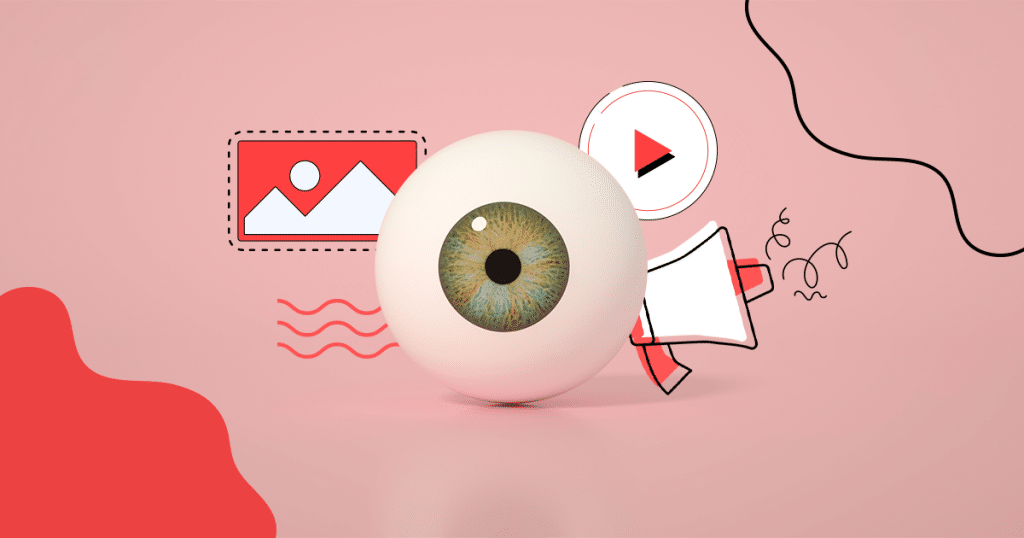Have you ever heard of visual marketing?
Such a powerful tool can leverage great results from your strategy while using the best kinds of content in innovative ways.
Images, videos, infographics, and even memes are examples of visual media that fit with several different kinds of businesses. All that you need to do is learn which works best with your brand, target audience, and goals.
Humans are visual creatures, so, naturally, working with visual marketing is such a promising approach. However, like with any other resource, you need to know how to use it to achieve good results.
In the following article, you will learn some visual marketing facts, which best practices need to be a part of your strategy, and discover some great examples for inspiration. Enjoy!
- What is visual marketing?
- What are the most common visual marketing content types?
- Why has visual marketing become a must-use? Some visual marketing facts
- What are the 10 best practices in visual marketing?
- What are some good and inspiring examples of visual marketing?
Download this post by entering your email below
What is visual marketing?
Visual marketing is the use of images, videos, and other pieces of multimedia content to strengthen your brand and communicate with your target audience.
As part of a larger marketing strategy, it helps you depict certain subjects and concepts that would otherwise be harder to approach by using only text.
Thanks to all the progress digital media has gone through in the last few years, there are many possibilities related to multimedia content and visual marketing.
Check this 3D video made for Kia by Visually. How could the brand explain all this technical information with just text? Boring, right?
A brand can invest its resources in infographics, interactive videos, animated GIFs, data visualization, and other types of content to successfully engage with their audience.
However, to truly enjoy the benefits brought by visual marketing, you and your team must understand how to properly use it.
Merely using images and videos whenever possible is not going to be enough, as a highly important part of the process relates to the planning and concept stages.
Before we continue, below you can find an outline of the most commonly known visual marketing content kinds.
What are the most common visual marketing content types?
Images
Web browsers have supported them for as long as most internet users can remember, and they are critical to web design and other fields.
Visual marketing as a strategy model takes this concept further and encourages you to find new ways to use images to captivate and engage your audience with your content.
Videos
With internet speeds becoming more reliable even on mobile phones, videos can now be used to properly communicate even the most complex subject to your audience.
They help you show your product, explain your service plans and even add that human touch with client interviews. Also, videos are highly versatile, as they can turn into almost any kind of content.
Infographics
Infographics combine text and visual elements to deliver information in unique ways. The priority is conciseness and intuitiveness through data visualization. They are highly shareable, which means people are naturally drawn to them and usually feel compelled to share them on social media.
Check this infographic made for Sumo Logic to explain how to use the app in the right way. Simple, beautiful and effective.

There are various approaches to infographics, but you should always choose the one that is appropriate for your brand and channel—for instance, working data visualization for mobile helps you create the right content for smaller devices.
Presentations
A slide deck might help get your message across. Web browsers support embedded slide presentations and interactive tools can contain several kinds of visual content within themselves. This might be the best choice if you need to communicate a lot of information and retain your brand identity.
This presentation from Bosch educates customers about their environmental sustainability.

Quotes
People like reading inspiring and impactful quotes. That makes them very effective pieces of visual content and a perfect fit for your strategy. Naturally, the quotes themselves need to be able to communicate with your target audience and fit your brand. To increase your odds of shares, it is important to use beautiful backgrounds on your quotes.
Memes
Are you surprised? Memes are highly viral and can help your brand reach a completely new level of exposition. The funny images that reference pop culture, daily life, and other topics with a touch of humor can only help your brand if you truly understand the format and add value to the conversation.
It is also important to remember that memes come and go pretty fast, so keep an eye on social media.
Why has visual marketing become a must-use? Some visual marketing facts
You probably already heard the saying “A picture is worth a thousand words”. Its basis is the very foundation of visual marketing, since it relates to how there are times when images are a more effective way to communicate what you need.
Visual marketing hinges on the human characteristic that makes us very visual creatures. People can retain more information by looking at pictures instead of text. In fact, according to research, we can process images 60 thousand times faster than writing. This is an interesting visual marketing fact.
Using visuals also has a great effect on performance marketing. According to MDG Advertising, 60% of people are more likely to consider buying a product or hiring a service that has an image in search results. Besides, social media posts with images see over twice the engagement of those without.
What are the 10 best practices in visual marketing?
Visual marketing excels at using multimedia pieces to help you reach your goals. However, it can only do so if you use its elements appropriately. By making the right choices when planning and executing your strategy, you can increase your chances of achieving great results.
Here are the 10 best practices in visual marketing that you need to follow to successfully work with your content:
1. Align visual with textual
Any content you create needs to fit with the rest. While creating your pieces in visual marketing, all your elements need to be aligned. This means having a healthy balance between the resources you are using and the rest of your marketing strategy.
Consider how each element in your visual marketing content piece interacts with one another. Text is helpful for in-depth descriptions and short labels. Visual elements might help fill the gaps left by the other and capture your audience’s attention.
If you create an unbalanced piece, it might have a hard time reaching the results you are hoping for. Avoid that by carefully planning every aspect of your content while being careful to stay true to your brand’s message and history.
2. Be helpful
Prioritize delivering helpful information to your target audience. With so much competition for people’s attention on the internet, those who win are usually the ones that publish helpful content. Visual marketing is a great tool to make that happen, so the resulting combination is highly beneficial to your brand.
Being helpful primarily means understanding what your audience needs. Such information is very valuable for effective client communication, but here serves the critical role of helping you anticipate your audience’s reaction.
By learning what they need, it is easier to create a piece of content that truly helps them. Lastly, never stop researching this, as tastes and needs might change with time and they need to be reflected in your content.
3. Stay on brand
Visual marketing employs several different kinds of content to deliver your message, but that does not mean you should forget about staying on brand. Even on the most innovative infographic or interactive video, you must always have your business speaking as it always does and talking about values as it always has.
After all, visual marketing is all about leveraging the power of visuals to create more effective content pieces. A critical part of your planning involves considering how your brand talks, its colors, shapes, and designs. Never forget to apply all of those when creating your pieces.
Finally, staying on brand also means being true to your recurring messages. Communicating with your target audience requires you to be coherent in the way that you put your brand out there. For instance, if you never used humor as part of your strategy, it makes no sense to suddenly start publishing memes.
4. Use clear call-to-actions
Visual marketing can help you get your potential leads to the next stages in the buyer’s journey. To do that, make sure to employ the appropriate call-to-action (CTA) in each piece while considering its individual goals and target audience.
Coming up with a strategic CTA usually involves two major steps. The first one is defining where you want your audience to go after consuming that piece of content. After that, you need to come up with the right message to convince them to take that leap.
Big flashy buttons are not necessarily the best choice in all cases. Use your brand’s style to show the value of that next step and guide your audience by using a CTA that fits with the visual marketing piece and your brand’s identity.
5. Repost and repurpose
A single piece of content can turn into many others depending on your approach. This is very true for visual marketing and can help you get a lot more value out of your creations and even learn more about your audience’s tastes.
First, you do not need to limit yourself to posting your content only once. Create an editorial schedule in which some reposts are allowed, which helps your message be seen by those who missed it the first time.
Then, keep an eye out for potential remixes you might come up with. A video can be turned into an infographic, or the other way around. A single image may take another form when combined with another piece of content. The result might get even better performance than the originals.
6. Let go of stock images
Everyone is tired of seeing the same photos everywhere. The smiling executives shaking hands. The happy woman eating a salad. Stock images might damage your ability to truly connect with your audience and even devalue your visual marketing strategy.
Visual does not have to mean stock photos. People can detect generic content. Plan your marketing around the tools you have at your disposal and the people at your business.
For instance, instead of using a video of several people around a table in a meeting, why not create an animated video with the same idea? It might be able to capture the attention of more people and is a unique solution to your brand.
7. Adapt to each platform
While creating your visual marketing pieces, never forget to adapt them to each channel you will publish them on. Using the same content in multiple places can damage our ability to communicate properly.
For instance, if you are posting an animated video on Instagram, it is important to be mindful of the duration limit. Also, an infographic might not work that well on that platform because of the size, but what if you split it into multiple parts and create a carousel post?
Because of such variations, it is important to carefully consider where your brand is present and how it communicates on each platform. More channels means more time focused on such adaptations.
8. Run A/B tests
It is almost impossible to get everything right on your first try. Thankfully, technology can help you with that. All that you need to do is run some A/B tests on your visual marketing pieces to learn what the best approaches are.
With A/B testing, you run similar versions of the same piece of content with variations such as style, colors, and approach. Then, you compare the results they obtained and pick the variant that was able to get you closer to your goal.
This means that you can always find out what elements can bring better results to your content. By running constant A/B tests, you can not only put out the best pieces but also learn more about your target audience.
9. Make sharing easy
Would you like to leverage visual marketing’s viral potential? Then, you need to make it easy for people to share your content pieces. Sometimes, all that it takes for your shares count to rise is to offer an easy share button.
This might require some changes to your owned media, such as a blog or a website. Avoid being pushy, as people might be turned off by that. Instead, make your share button available, but not overbearing.
On that topic, do not forget to properly brand your pieces to make sure they carry the name of your business when reaching new audiences. For instance, add your logo to your infographic and even the URL to your website.
10. Use the right tools
Visual marketing is only able to help you reach good results when you use good tools to create your pieces. After all, wasting time on a lesser solution that does not deliver quality is a huge waste of potential.
Make sure to pick a tool that helps you plan your creative pieces accordingly and has the resources you need to create what your brand requires. It is even better if such a tool is tailor-made to be used for visual marketing purposes.
A good way to make sure a tool is promising is to look at the pieces people produced while using them. Try to look for results that are similar to the ones you wish to create.
What are some good and inspiring examples of visual marketing?
The best way to learn about a concept is to check some of its best examples. There is a vast variety of content within visual marketing, but you can understand its value by considering how each type can communicate and strengthen a brand through its message.
Here are the best examples of visual marketing in action to inspire your strategy.
Infographics provide great ways to communicate even the most complex ideas more easily.
You can use the combination of text and images to create beautiful compositions that captivate the audience and can even go viral. Data literacy is required to understand how all the numbers you have relate to one another.


Animated videos are great tools to depict and explain difficult concepts. Informative videos are great tools to deliver value to your audience as they attract people’s attention with the promise of being helpful.
A flowchart sounds like something you would see in a Chemistry book or a business-oriented discussion. However, if it is intuitive and helpful, it might be interesting to a broader audience. In this example, you can see a lifestyle approach that uses the flowchart format to help with love and texting.

Below, you can see how a minimalistic animation can capture a lot of meaning through its references. Visual marketing is all about using analogies to help your audience connect the dots and reach your intended meanings.
Since it is a video and it deals with a beloved medium like movies, it has a high viral potential.
Working with visual marketing is a great way to communicate with your audience in innovative ways and reach the results you wish. People are overloaded with information every day, so your brand needs new and effective ways to reach them and get its message across. Using the right kinds of visual content will help you do that.
Visual.ly can help you leverage visual marketing’s true potential by offering the right tools for the job.
Go on our website, tell us about your project and receive a quote within one business day.









